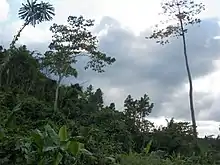Flora of the Philippines
The flora of the Philippines includes several species of plants and plant-like organisms. At the very least, one-third of the more than 9,250 vascular plant species native to the country are endemic.[1] There are, however, no plant families endemic to the country. The families of gingers, begonias, gesneriads, orchids, pandans, palms, and dipterocarps are particularly high in endemic species. For example, two-thirds of the 150 species of palms present in the country are found nowhere else in the world. There are over 137 genera and about 998 species of orchids so far recorded in the Philippines as of 2007.[2]

The broad lowland and hill rain forests of the Philippines, which are mostly gone today, were dominated by at least 45 species of dipterocarps. These massive trees were abundant to up to 1,000 meters above sea level. Other important tree species here include giant figs, which provide food for fruit bats, parrots, and monkeys, and Pterocarpus indicus, which like the dipterocarps, is valued for its timber.
A few species of Rafflesia are found in the Philippines,[3] one of them being Rafflesia philippensis.[4]
List
- Abaca – Musa textilis
- Acacia
- Almaciga – Agathis philippinensis
- Atis – Annona squamosa
- Banaba – Lagerstroemia speciosa
- Banana
- Bayabas – Psidium guajava
- Breadfruit – Artocarpus altilis
- Caimito – Chrysophyllum cainito
- Calachuchi – Plumeria obtusa
- Dama de Noche – Cestrum nocturnum
- Gumamela – Hibiscus rosa-sinensis
- Guyabano – Annona muricata
- Strongylodon macrobotrys -
- Kamagong – Diospyros blancoi
- Langka – Artocarpus heterophylla
- Lanzones – Lansium parasiticum
- Mahogany
- Makopa – Syzygium samarangense
- Mangga – Mangifera indica
- Molave – Vitex parviflora
- Narra – Philippine cedar; Pterocarpus indicus
- Niyog – Cocos nucifera
- Nipa – Nypa fruticans
- Orchid – Phalaenopsis hieroglyphica
- Pineapple – Ananas comosus
- Philippine Lily – Lilium philippinense
- Pomelo – Citrus maxima
- Rafflesia
- Rattan – Calamus
- Sampaguita – Jasminum sambac
- Santan – Ixora coccinea
- Sugarcane
- Talong punay - Datura metel
- Tobacco
- Tuba-tuba – Jatropha curcas
- Ube – Dioscorea alata
- Waling-waling – Euanthe sanderiana
- Yakal – Shorea astylosa
- Ylang-ylang – Cananga odorata
References
- Das, Indraneil; Tuen, Andrew Alek. Naturalists, Explorers and Field Scientists in South-East Asia and Australasia. Springer. p. 243. ISBN 978-3-319-26161-4. Retrieved 2 January 2021.
- Agoo, Esperanza Maribel G. (June 2007). "Status of Orchid Taxonomy Research in the Philippines" (PDF). Philippine Journal of Systematic Biology. 1. Retrieved July 23, 2020.
- Wikramanayake, Eric D.; Dinerstein, Eric; Loucks, Colby J. Terrestrial Ecoregions of the Indo-Pacific: A Conservation Assessment. Island Press. p. 146. ISBN 978-1-55963-923-1. Retrieved 2 January 2021.
- Barcelona, J.F.; Pelser, P.B.; Balete, D.S.; Co, L.L. (30 October 2009). "Taxonomy, ecology, and conservation status of Philippine Rafflesia (Rafflesiaceae)". The Parasitic Plant Connection. Southern Illinois University. Archived from the original (PDF) on 24 December 2020. Retrieved 2 January 2021.
